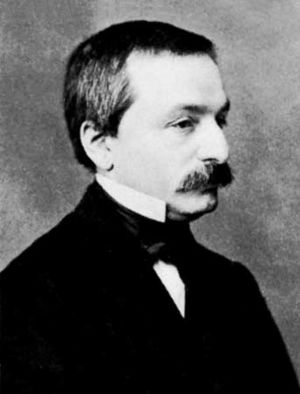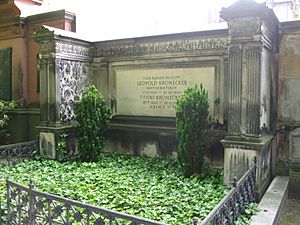Leopold Kronecker facts for kids
Quick facts for kids
Leopold Kronecker
|
|
|---|---|

Leopold Kronecker in 1865
|
|
| Born | 7 December 1823 |
| Died | 29 December 1891 (aged 68) |
| Nationality | Prussian |
| Alma mater | University of Berlin |
| Known for |
|
| Scientific career | |
| Fields | |
| Institutions |
|
| Doctoral advisor | |
| Doctoral students |
|
Leopold Kronecker (born December 7, 1823 – died December 29, 1891) was a German mathematician. He worked on number theory, algebra, and logic. Kronecker is famous for his belief that "God made the integers, all else is the work of man." This means he thought that only whole numbers were truly real in mathematics. He was a student and friend of Ernst Kummer.
Contents
Biography
Leopold Kronecker was born on December 7, 1823, in Liegnitz, Prussia (now Legnica, Poland). His family was wealthy. His parents, Isidor and Johanna, made sure their children had a good education. They even had private tutors at home. Leopold's younger brother, Hugo, also became a scientist, a famous physiologist.
Kronecker went to the Liegnitz Gymnasium, which is like a high school. He was interested in many subjects, including science, history, and philosophy. He also enjoyed gymnastics and swimming. His math teacher, Ernst Kummer, saw his talent and encouraged him.
In 1841, Kronecker started studying at the University of Berlin. At first, he didn't focus only on mathematics. He also studied astronomy and philosophy. In 1845, he finished his main project (called a dissertation) in algebraic number theory. His teacher, Peter Gustav Lejeune Dirichlet, helped him with it.
Life After University
After getting his degree, Kronecker didn't become a professor right away. He went back to his hometown to manage a large family farm. In 1848, he married his cousin, Fanny Prausnitzer. They had six children. For several years, Kronecker focused on his business. He still studied math as a hobby and wrote letters to Kummer, but he didn't publish any new math papers.
In 1853, he wrote an important paper about solving equations using Galois theory. This paper showed his deep understanding of mathematics.
Return to Academia
Because his business made him financially comfortable, Kronecker was able to return to Berlin in 1855. He decided to study mathematics full-time as a private scholar. He became good friends with Karl Weierstrass, another important mathematician. He also reconnected with his former teacher, Kummer.
Over the next few years, Kronecker published many papers based on his own research. Because of his excellent work, he was chosen to be a member of the Berlin Academy in 1861.
Even though he didn't have a regular university job, being a member of the Academy allowed him to teach classes at the University of Berlin. He started teaching there in 1862. In 1866, he was offered a math professor job at the University of Göttingen. This job had been held by famous mathematicians like Carl Friedrich Gauss. But Kronecker turned it down, preferring to stay at the Academy.
Finally, in 1883, when Kummer retired, Kronecker was invited to take his place. He became a full professor at the University of Berlin. He taught and guided many students, including Kurt Hensel and Franz Mertens.
Kronecker had strong beliefs about what mathematics should be. These ideas sometimes caused disagreements with other mathematicians, like Weierstrass. Kronecker died on December 29, 1891, in Berlin. He is buried in a cemetery in Berlin.
Scientific Activity
Mathematics Research
A big part of Kronecker's work was in number theory and algebra. In 1853, he wrote about the theory of equations. He came up with the Kronecker–Weber theorem, which was later fully proven by David Hilbert. He also helped develop the idea of how abelian groups are structured.
Kronecker also studied elliptic functions. He had a special idea he called his "dearest dream of youth." This idea was later expanded by Hilbert as one of his famous 12 problems. In 1850, Kronecker found a way to solve the quintic equation (an equation with a variable raised to the power of five) using group theory.
In algebraic number theory, Kronecker introduced his own way of thinking about "divisors." This was different from another mathematician's idea of "ideals." Even though his method was not widely used at first, it was later found to be very helpful by other mathematicians.
Kronecker also helped us understand continuity in math. He worked on how irrational numbers fit into real numbers. He disagreed with his colleague, Karl Weierstrass, about a certain type of continuous, nowhere differentiable function.
Many mathematical ideas are named after Kronecker. These include the Kronecker limit formula, Kronecker's congruence, Kronecker delta, Kronecker comb, Kronecker symbol, Kronecker product, Kronecker's method for factoring polynomials, Kronecker substitution, Kronecker's theorem in number theory, Kronecker's lemma, and Eisenstein–Kronecker numbers.
Philosophy of Mathematics
Kronecker believed that only whole numbers (integers) were truly real and certain in mathematics. This idea is called finitism. His views were an early step towards a way of thinking called intuitionism in the foundations of mathematics. Intuitionism focuses on building math from very basic, clear concepts.
Honours
Kronecker was chosen as a member of several important academies:
- Prussian Academy of Sciences (1861)
- French Academy of Sciences (1868)
- Royal Society (1884)
The asteroid 25624 Kronecker is named after him.
See also
 In Spanish: Leopold Kronecker para niños
In Spanish: Leopold Kronecker para niños


